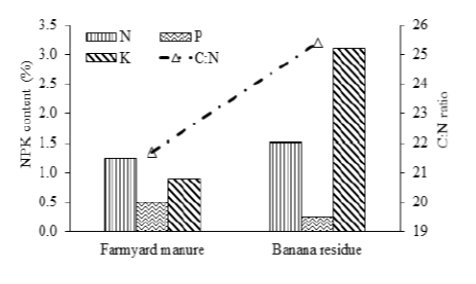


Indian Journal of Science and Technology
DOI: 10.17485/IJST/v14i11.1992
Year: 2021, Volume: 14, Issue: 11, Pages: 932-941
Original Article
Ayaz Virk1, Kazi Suleman Memon1, Mehrunisa Memon1*, Sadia Hussain1
1Department of Soil Science, Sindh Agriculture University Tandojam, Sindh, 70060, Pakistan.
Tel.: +92-331-350-5301
*Corresponding Author
Tel: +92-331-350-5301
Email: [email protected]
Received Date:02 November 2020, Accepted Date:11 March 2021, Published Date:09 April 2021
Background/Objectives: Recycling banana residue in the form of compost presents good potential for carbon sequestration and improved nutrient supply. The main objectives of the study were to formulate a banana residuebased product and determine its impact on maize growth, nutrition and soil properties. Methods: Selected compost products (0+100, 50+50, 60+40 and 70+30 banana residue and farmyard manure) designated as CP-1, CP-2, CP-3, and CP-4) and four fertilizer rates (0,1/3rd 2/3rd and Full NP) were placed in a randomized complete block design with three replications, using maize as a test crop. Standard procedures were used for compost, soil and plant analysis. Total organic C and N in compost were analyzed on CHNS Analyzer and P and K by acid (1:5 HClO4 - HNO3) digestion, followed by quantification, correspondingly using spectrophotometry and emission spectroscopy. Findings: The banana residue had higher N (1.51%) and K (3.10%) than farmyard manure (1.24% and 0.9%) but it had relatively more P (0.5%) than banana residue (0.24%), The N (1.57-1.71%) and K (1.10-3.10%) contents of the compost products increased with the decrease in the quantity of farmyard manure and increase in banana residue, while, P decreased under the same scenario. Maize plants grew healthier with compost products or fertilizer treatments. This was reflected in the increase in mean shoot dry weights by 38.4% over control. Shoot N increased from 1.50-3.36%, P 0.29-0.51% and K 0.74-1.06% receiving compost products and NP fertilizers. There was no effect of compost products on EC or pH of soil. The soil organic matter (0.9-1.70%), and Olsen P (7.70-13.23 mg kg-1) almost doubled, while, NH4OAc-K (240-307 mg kg-1) also increased by 30%. The co-composting of banana residue with farmyard manure narrowed the C: N ratio over individual materials, increased the nutrient concentration and growth of maize and enhanced the efficiency of NP fertilizer and increased the fertility of the soil. Based on physical appearance and properties, four compost products CP-1, CP-2, CP-3 equally. This study showed that banana residue could be beneficially composted with farmyard manure for improved yield and nutrition of maize. It is proposed that compost products should be evaluated under a natural soil environment. Novelty/Applications: Co-composting of banana residue with farmyard manure is a new aspect of preparing compost products. A mixed blend of both materials, in the form of compost products, consisted of significant quantities of major nutrients like nitrogen, phosphorus and potassium.
Keywords: Banana residue; compost product; Maize; soil properties
© 2021 Virk et al.This is an open-access article distributed under the terms of the Creative Commons Attribution License, which permits unrestricted use, distribution, and reproduction in any medium, provided the original author and source are credited. Published By Indian Society for Education and Environment (iSee).
Subscribe now for latest articles and news.